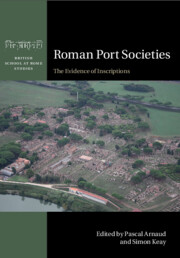Book contents
- Roman Port Societies
- British School at Rome Studies
- Roman Port Societies
- Copyright page
- Contents
- Figures
- Tables
- Contributors
- Abbreviations
- 1 The Context of Roman Mediterranean Port Societies
- 2 Inscriptions and Port Societies
- 3 Stationes and Associations of Merchants at Puteoli and Delos
- 4 Boatmen and their Corpora in the Great Ports of the Roman West (Second to Third Centuries AD)
- 5 Roman Port Societies and Their Collegia
- 6 Port Occupations and Social Hierarchies
- 7 Warehouse Societies
- 8 The Imperial Cult and the Sacred Bonds of Roman Overseas Commerce
- 9 Law and Life in Roman Harbours
- 10 Living Like a Cosmopolitan?
- 11 Ports, Trade and Supply Routes in Western Europe
- 12 The Port Society of Narona
- 13 Municipal Authority, Central Authority and Euergetists at Work at the Port
- 14 The Structure of Mercantile Communities in the Roman World
- 15 Polysemy, Epigraphic Habit and Social Legibility of Maritime Shippers
- 16 Reading Roman Port Societies
- Indexes
- References
11 - Ports, Trade and Supply Routes in WesternEurope
The Case of Narbonne
Published online by Cambridge University Press: 30 October 2020
- Roman Port Societies
- British School at Rome Studies
- Roman Port Societies
- Copyright page
- Contents
- Figures
- Tables
- Contributors
- Abbreviations
- 1 The Context of Roman Mediterranean Port Societies
- 2 Inscriptions and Port Societies
- 3 Stationes and Associations of Merchants at Puteoli and Delos
- 4 Boatmen and their Corpora in the Great Ports of the Roman West (Second to Third Centuries AD)
- 5 Roman Port Societies and Their Collegia
- 6 Port Occupations and Social Hierarchies
- 7 Warehouse Societies
- 8 The Imperial Cult and the Sacred Bonds of Roman Overseas Commerce
- 9 Law and Life in Roman Harbours
- 10 Living Like a Cosmopolitan?
- 11 Ports, Trade and Supply Routes in Western Europe
- 12 The Port Society of Narona
- 13 Municipal Authority, Central Authority and Euergetists at Work at the Port
- 14 The Structure of Mercantile Communities in the Roman World
- 15 Polysemy, Epigraphic Habit and Social Legibility of Maritime Shippers
- 16 Reading Roman Port Societies
- Indexes
- References
Summary
The exploration of this subject is based principally onepigraphic evidence, as illustrated in Hatzfeld’sground-breaking work of 1919, to which may now beadded the epigraphy of production and commerce,which goes hand in hand with trade and to which itowes its existence. The case studied here deals withthe most westerly part of the Mediterranean,providing access to the continent through thenetwork of routes from the areas around theAquitaine isthmus and the Rhône isthmus as far asthe Rhine and Garonne basins and out to the AtlanticOcean. It looks at dynamic trends, phenomena whichvary over time, just as contexts and economiccircumstances may vary. These trends are integratedwithin the space formed by the routes created andused by people. The study deals with the commercialactivities related to the production, transportationand consumption of goods, as well as the networksand directions of trade routes. Ports are importantpoints of passage, places where goods aretransferred, stored and distributed, as well asbeing the principal or secondary places ofbusiness.
- Type
- Chapter
- Information
- Roman Port SocietiesThe Evidence of Inscriptions, pp. 241 - 265Publisher: Cambridge University PressPrint publication year: 2020
References
- 1
- Cited by

